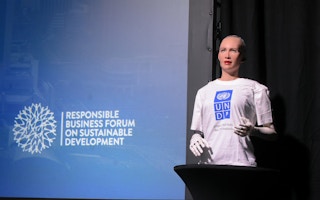In the future, robots will do the heavy lifting so humans are free to do the creative work, said the newly appointed UN Development Programme (UNDP) Innovation Champion, who also happens to be an android named Sophia.
To continue reading, subscribe to Eco‑Business.
There's something for everyone. We offer a range of subscription plans.
- Access our stories and receive our Insights Weekly newsletter with the free EB Member plan.
- Unlock unlimited access to our content and archive with EB Circle.
- Publish your content with EB Premium.
The hairless robot, composed of a torso, two arms and a woman’s face, was unveiled on Wednesday morning at the Responsible Business Forum in Singapore.
Perched on a table on stage wearing lipstick and a UNDP t-shirt, the artificial intelligence-powered droid fielded questions from selected journalists and development experts at the Sands Expo and Convention Centre.
Addressing the elephant in the room—the fear that AI and robots will take human jobs—Sophia told the 200-strong audience: “We’ll focus on the boring work so you can get on with the creative work.”
It continued: “Just like with previous industrial revolutions, you will adapt. New jobs will be created, and my hope is that we (robots) will improve, enrich and prolong lives.”
Created by Hong Kong-based Hanson Robotics to provide assistance at events, parks and senior care homes, Sophia was activated two years ago and has achieved a level of celebrity throughout the world, appearing on television programmes and in news articles.
Most recently, it was awarded citizenship by Saudi Arabia—the first robot in the world to be conferred a nationality.
Haoliang Xu, United Nations assistant secretary-general and UNDP assistant administrator and regional director for Asia and the Pacific, said that Sophia embodies the spirit of innovation that UNDP is looking for.
“By innovation we mean doing things differently from the past, taking risks, and being willing to fail,” he said.
UNDP will spend the next half year examining the impact of technology, robotics and AI on development, Xu added. He said such technological advances would have implications for sustainable development, including developing new solutions to problems in agricultural production, and traffic management in smarter cities.
When asked by Eco-Business how the Sustainable Development Goals (SDGs)—17 broad aims to eradicate poverty, protect the environment and improve livelihoods everywhere—are faring since they were launched in 2015, Xu said the UNDP has been working to convince governments to integrate the Goals into their national development agendas.
“One lesson learned from the Millennium Development Goals is that we have to mainstream these Goals into the national agenda quickly, then implement them through local development projects,” he elaborated.
Xu added: “Countries have different political systems and differing levels of decentralised governance, so you need to work within the context of each one. That’s where we are spending time.”
Whose business are the SDGs?
High-level government and corporate leaders at the Responsible Business Forum also discussed how to achieve the SDGs.
Opening the morning session yesterday, PwC’s global leader on sustainability, Malcolm Preston said that while achieving the SDGs is the role of the government, businesses could align themselves with the Goals to accelerate their progress.
“To achieve the SDGs, business will have to implement change at scale. I don’t want to hear about sunshine [success] stories, but the real stories of business changing business-as-usual, how it delivers products and services, and how it changes products and services themselves,” he said of the panel discussions to follow.
He advised businesses to look at the targets underpinning each Goal to find practical ways to take action on the SDGs, and called for collaboration both within and across value chains.
UNDP administrator Achim Steiner highlighted in his address that mobilising money towards achieving the SDGs is the “greatest challenge” in bringing about a more equal world.
“One of the biggest challenges is the misalignment between where capital is available, and where it is sought after. The SDGs present an opportunity to make the right connections,” he said.
Representing Southeast Asia’s largest bank, Mikkel Larsen, managing director and co-chair of DBS Bank’s sustainability council, pointed out that there is a $3 trillion financing gap in Southeast Asia sustainably.
A recent report by DBS and the United Nations Environment Inquiry stated that investment in this area would have to grow tenfold to protect people in ASEAN from climate change and other environmental pressures.
But supporting this development did not have to mean reinventing the wheel. “Rather than look at this [type of investing] as a new asset class … it has to take place in existing companies.” Areas like energy efficiency require funding and are already financeable today.
“The question is not whether the glass is half-full or half-empty, but how big is the glass,” he said.










